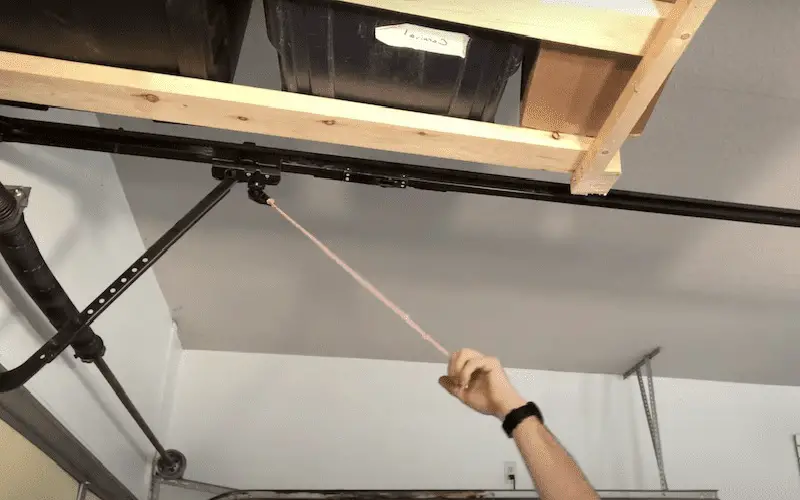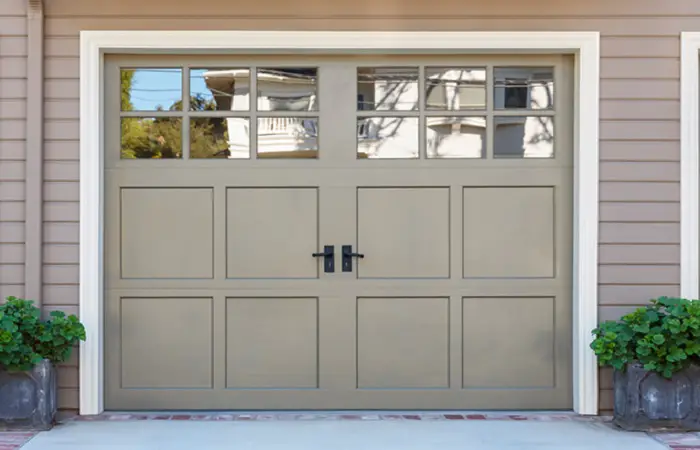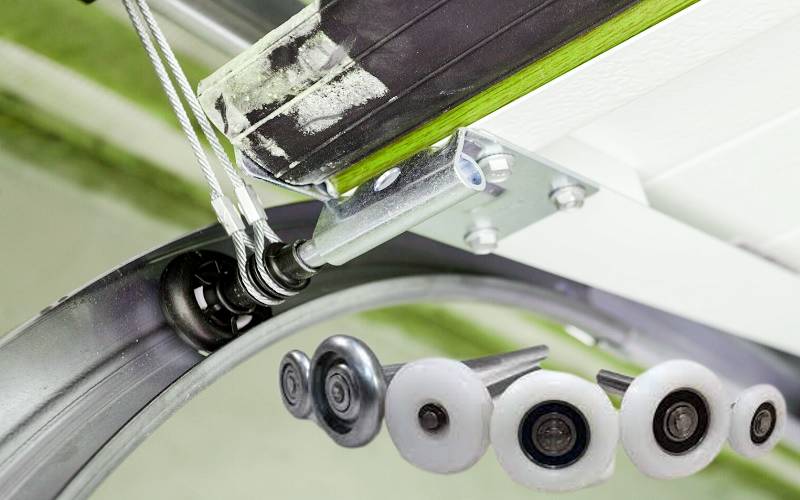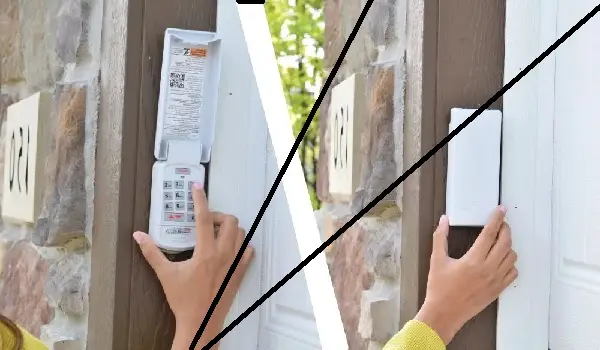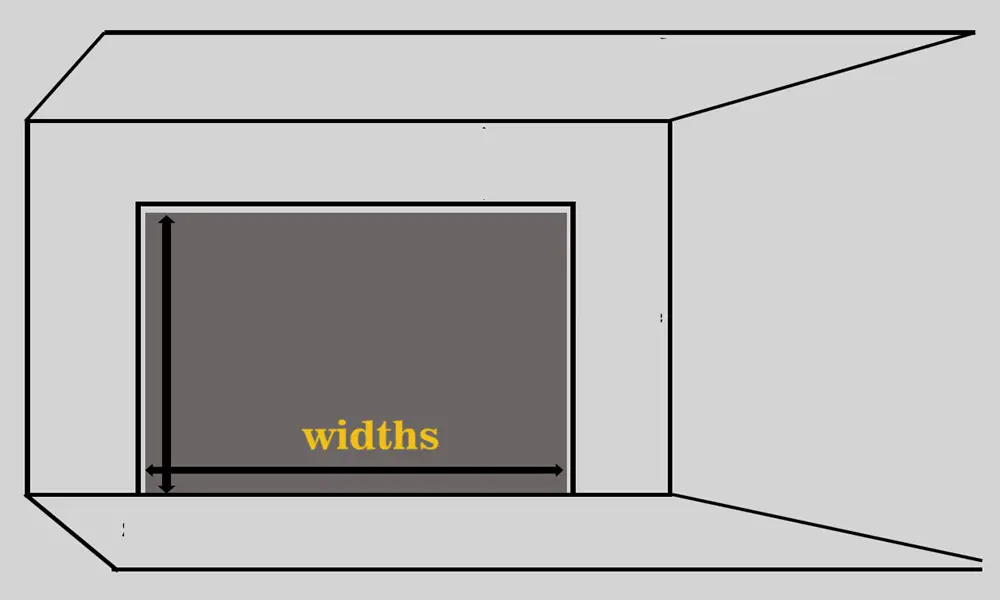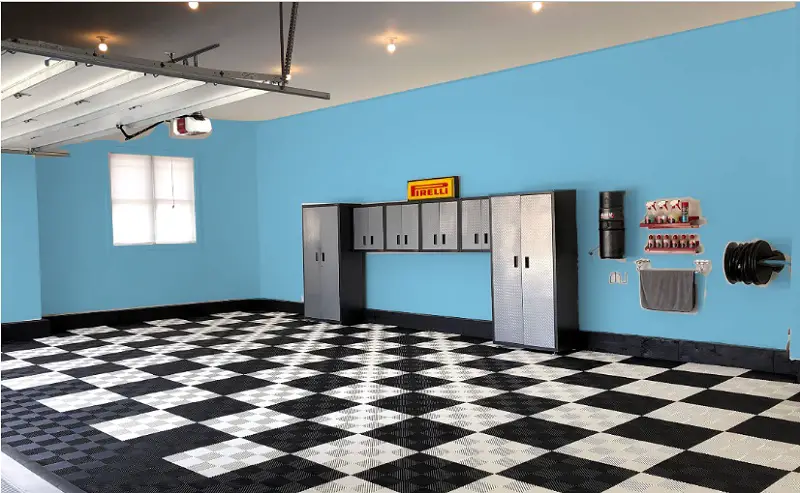What Size Torsion Spring for 16×7 Garage Door
What Size Torsion Spring for 16×7 Garage Door When it comes to ensuring the smooth and safe operation of your […]

What Size Torsion Spring for 16×7 Garage Door
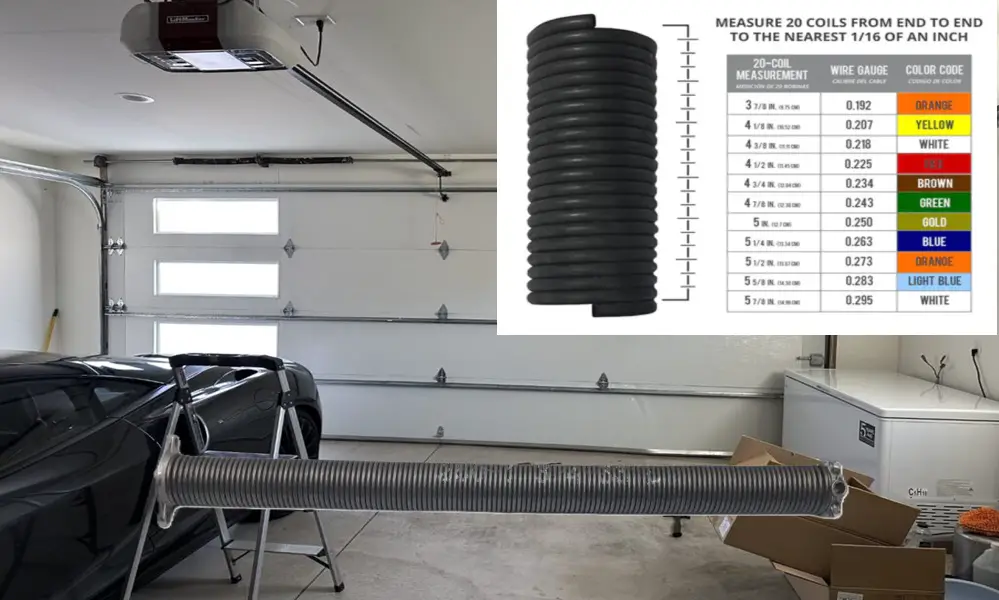
When it comes to ensuring the smooth and safe operation of your 16×7 garage door, selecting the correct torsion spring size is of utmost importance. The size of the torsion spring plays a crucial role in balancing the door’s weight and providing the necessary lifting force.
So, how do you determine the right size torsion spring for your 16×7 garage door? That’s what I will be discussing in this article. I will guide you through the factors that determine the appropriate size and provide valuable insights into finding the ideal torsion spring.
By understanding the importance of selecting the correct torsion spring size and considering the specific measurements and characteristics of your garage door, you can ensure optimal performance and avoid potential problems down the line.
Let’s get started on finding the perfect torsion spring size for your 16×7 garage door!
Understanding Torsion Springs
Before determining the size of a torsion spring, it is important to understand the basics of how these springs work and the different variables that affect their sizing. Torsion springs are designed to store mechanical energy when twisted or torqued, and they provide the necessary force to counterbalance the weight of a garage door.
Weight calculations play a crucial role in selecting the right torsion spring for your 16×7 garage door. By accurately assessing the weight of the door, you can ensure that the spring is capable of supporting and balancing the door’s weight effectively. Torsion spring weight calculators are valuable tools that simplify this process. These calculators take into account factors such as door material, size, and track radius to provide an accurate weight estimation.
| Torsion Spring Conversion Chart | Wire Diameter (Inches) | Coil Diameter (Inches) | Spring Length (Inches) | Door Height (Feet) |
|---|---|---|---|---|
| Standard Residential | 0.225 | 2.625 | 28 | 7 |
| Heavy Duty Commercial | 0.2625 | 3.125 | 33 | 7 |
| Extra Heavy Duty Commercial | 0.283 | 3.625 | 38 | 7 |
Conversion charts are also utilized in the process of selecting torsion springs. These charts provide comprehensive information, such as wire diameter, coil diameter, spring length, and appropriate door heights for different springs. By referring to a conversion chart, you can easily determine the suitable torsion spring size based on your door height and other relevant factors.
By understanding torsion spring weight calculations and utilizing conversion charts, you can confidently select the right torsion spring size that ensures the safe and efficient operation of your 16×7 garage door.
Importance of Proper Spring Size
Choosing the correct torsion spring size for your 16×7 garage door is essential for ensuring safe and smooth operation. Using the wrong size can lead to potential risks and result in unexpected costs.
When the spring size is too small, it may not have enough strength to support the weight of the garage door. This can cause excessive strain on the opener system and lead to premature wear and tear. Additionally, an undersized spring may not provide enough counterbalance, making it difficult to open and close the door smoothly.
On the other hand, if the spring size is too large, it can create excessive tension on the door and pose a safety hazard. The door may become difficult to control and potentially slam shut, causing damage to the door, property, or even posing a risk to people.
Using the proper spring size not only ensures smooth and safe operation but also helps extend the lifespan of your garage door components. By distributing the weight evenly and providing the right amount of counterbalance, the door and opener system can function optimally, reducing the need for frequent repairs or premature replacement.
It’s important to remember that the size of the spring is determined by various factors, including the weight of the garage door, the track radius, and the cycle life. Each factor plays a crucial role in calculating the appropriate spring size and ensuring its compatibility with your specific door and operating conditions.
Using the correct torsion spring size can save you from potential risks, costly repairs, and premature replacements. Ensure the smooth and safe operation of your 16×7 garage door by selecting the right spring size that fits your door’s specifications.
Risks and Costs Associated with Incorrect Spring Size
| Risks | Costs |
|---|---|
| Excessive strain on opener system | Cost of repairing or replacing opener components |
| Difficulties in opening and closing the door | Cost of addressing door operation issues |
| Potential safety hazards | Cost of property damage or personal injury |
| Premature wear and tear | Cost of frequent repairs or premature replacement |
Measuring Your Garage Door
Accurate measurements are crucial when determining the appropriate torsion spring size for your 16×7 garage door. By following the correct measuring process, you ensure precise calculations for spring selection, which ultimately guarantees the optimal functionality of your garage door system.
To measure your garage door properly, I recommend following these steps:
- Begin by closing the garage door completely.
- Measure the height of the door from the floor to the top of the opening. Use a tape measure for accuracy.
- Next, measure the width of the door. Start from one side of the opening to the other.
- It is essential to measure the inside diameter (ID) and wire size of the existing torsion spring. This information can be found stamped on the spring itself. If you are replacing the spring, these measurements will provide a good reference for selecting the appropriate replacement.
- Finally, measure the inside diameter (ID) and outside diameter (OD) of the torsion tube or shaft. These measurements will help determine the size and type of torsion spring assembly needed for your garage door.
Remember to take accurate measurements, ensuring precision when selecting the torsion spring size. If you are unsure or need assistance, it’s always advisable to consult a professional garage door specialist who can guide you through the process and provide expert recommendations.
“Accurate measurements are the foundation for choosing the correct torsion spring size for your garage door. Skipping this crucial step can lead to improper spring selection and potential complications in the long run.” – Garage Door Specialist
Factors Influencing Torsion Spring Size
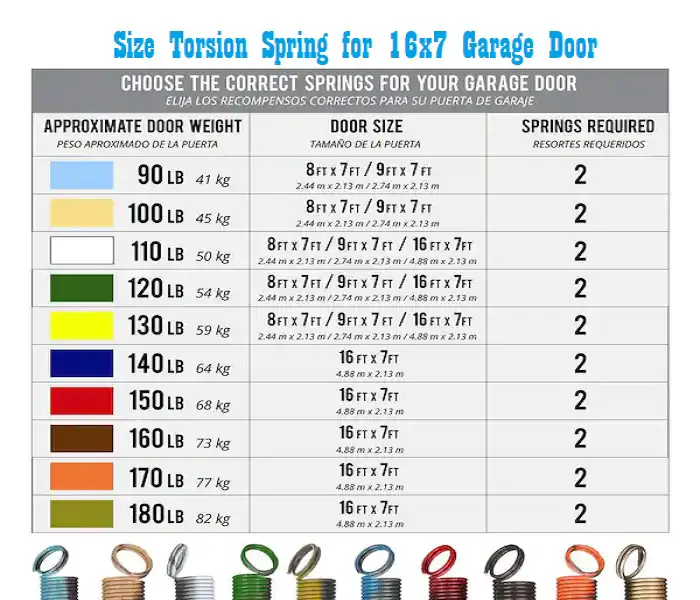
Choosing the right torsion spring for your 16×7 garage door involves considering various factors that influence the size of the spring. By understanding these factors, you can ensure optimal performance and avoid potential issues. Let’s explore the key elements that determine the ideal torsion spring size for your garage door:
1. Weight of the Garage Door
The weight of the garage door plays a crucial role in determining the appropriate torsion spring size. A heavier door requires a stronger spring to counterbalance its weight effectively. To calculate the weight of your garage door accurately, you can use a torsion spring weight calculator, which takes into account the door’s dimensions and the material it’s made of. By inputting these details into the calculator, you can obtain a reliable estimate of the spring’s weight rating.
2. Track Radius
The track radius refers to the curve of the horizontal track that guides the movement of the garage door. It is an important factor to consider when selecting a torsion spring. The track radius determines the distance between the center of the door shaft and the inside edge of the vertical track. By measuring this distance accurately, you can ensure that the torsion spring fits properly and operates smoothly.
3. Cycle Life
The cycle life of a torsion spring refers to the number of times it can open and close before losing its effectiveness. Higher-quality springs typically have a longer cycle life, providing reliable performance over an extended period. When choosing the best torsion spring for your 16×7 garage door, consider the expected usage and select a spring with a cycle life that meets your requirements. This will ensure longevity and reduce the need for frequent spring replacements.
By taking into account these factors, you can make an informed decision when selecting the best torsion spring for your 16×7 garage door. Ensuring the proper size of the spring will contribute to the smooth and safe operation of your garage door system.
Garage Door Torsion Spring Calculator
In order to simplify the process of determining the correct torsion spring size for your 16×7 garage door, there are online calculators available. These calculators take various factors into account and provide you with precise recommendations for selecting the right torsion spring.
Using a garage door torsion spring calculator is straightforward. Simply input the required information, such as the weight of your garage door and the track radius, into the calculator. The calculator will then generate the appropriate torsion spring size based on the provided data.
By utilizing a garage door torsion spring calculator, you can save time and ensure accuracy in selecting the correct torsion spring for your 16×7 garage door. These calculators eliminate the guesswork and help you make an informed decision.
Remember to gather accurate measurements of your garage door before using the calculator. The precision of the measurements will directly impact the accuracy of the calculated spring size.
Benefits of Using a Garage Door Torsion Spring Calculator
Using a garage door torsion spring calculator offers several advantages:
- Accuracy: The calculator considers all relevant factors to provide precise torsion spring size recommendations for your 16×7 garage door.
- Time-saving: Instead of manually performing complex calculations, the calculator swiftly generates the optimal spring size.
- Ease of use: These calculators are designed to be user-friendly and intuitive, making the calculation process accessible to all.
By utilizing a garage door torsion spring calculator, you can confidently select the right torsion spring size for your 16×7 garage door, ensuring safe and efficient operation.
| Benefits of Using a Garage Door Torsion Spring Calculator |
|---|
| Accuracy |
| Time-saving |
| Ease of use |
Selecting the Right Torsion Spring Size
Now that you have gathered the necessary information about your garage door, including measurements and weight calculations, it’s time to select the right torsion spring size. Choosing the correct size is crucial for the optimal performance and safety of your 16×7 garage door. In this section, I will discuss the available torsion spring sizes and provide guidance to help you make an informed decision.
Available Torsion Spring Sizes
Torsion springs are available in a variety of sizes to accommodate different garage door weights and dimensions. The size of a torsion spring is typically determined by its wire size, inside diameter, and overall length. It’s important to select a spring size that can support the weight of your garage door while providing the necessary balance and tension.
Here is an overview of common torsion spring sizes suitable for 16×7 garage doors:
| Spring Size | Wire Size | Inside Diameter | Overall Length | Weight Capacity |
|---|---|---|---|---|
| 1 3/4″ x 32″ | 0.250″ | 1 3/4″ | 32″ | 150-200 lbs. |
| 2″ x 32″ | 0.250″ | 2″ | 32″ | 200-250 lbs. |
| 2 1/4″ x 32″ | 0.250″ | 2 1/4″ | 32″ | 250-300 lbs. |
| 2 5/8″ x 32″ | 0.283″ | 2 5/8″ | 32″ | 300-350 lbs. |
Choosing the Best Torsion Spring
When selecting the torsion spring size for your 16×7 garage door, consider not only its weight capacity but also factors such as door material, track radius, and cycle life. These factors can affect the overall performance and durability of the spring.
It is advisable to consult a professional or refer to the manufacturer’s recommendations to ensure the best torsion spring selection for your specific garage door. They can provide expert advice based on your door’s specifications and specific requirements.
In the next section, I will introduce you to a garage door torsion spring calculator that can further assist you in finding the ideal torsion spring size based on your door’s characteristics.
Professional Assistance for Spring Selection
While you can undertake the task of selecting the correct torsion spring size for your 16×7 garage door yourself, seeking professional assistance is always a good idea. Consulting a garage door specialist can provide you with valuable expertise and ensure that you choose the right spring for your specific garage door.
Working with a professional has several benefits. They have extensive knowledge and experience in garage door systems and can accurately assess your door’s needs. They will consider factors such as the weight of your garage door, track radius, and cycle life to determine the appropriate torsion spring size.
“A garage door specialist will ensure that you select the proper torsion spring size, minimizing the risk of using an incorrect spring that could potentially lead to safety hazards and costly repairs.”
They can also provide valuable guidance and recommendations based on your specific requirements. By assessing your garage door’s characteristics and usage patterns, professionals can help you choose the best spring for optimal performance and longevity.
When it comes to the cost of spring replacement, it is crucial to consider the potential expenses associated with using the wrong spring size. An incorrectly sized spring can lead to excessive strain on the garage door system, resulting in premature wear and tear, and ultimately, more frequent repairs or even replacement of the entire system.
While professional assistance may come with a cost, it can save you money in the long run by preventing expensive repairs and extending the lifespan of your garage door. The peace of mind that comes with knowing your torsion spring is properly selected and installed is invaluable.
Installation and Maintenance Tips
Once you have chosen the correct torsion spring size for your 16×7 garage door, proper installation and maintenance are crucial for optimal performance. Here are some useful tips to ensure a safe and efficient installation, as well as maintenance practices to extend the lifespan of your torsion spring.
1. Safe Installation Steps
When installing the torsion spring, always prioritize safety. Follow these steps for a smooth installation process:
- Secure the area: Clear the workspace of any debris or objects that may obstruct your movement.
- Use proper tools: Ensure you have the necessary tools, such as winding bars and safety glasses, before starting the installation.
- Release tension: Before replacing the spring, release the tension on the old spring to prevent accidents.
- Follow manufacturer’s instructions: Read and follow the specific guidelines provided by the manufacturer for your torsion spring installation.
2. Maintenance Practices
Maintaining your torsion spring properly can help prolong its lifespan and minimize the need for frequent replacements. Here are some essential maintenance practices:
- Lubrication: Regularly lubricate the moving parts of the garage door, including the torsion spring, hinges, and rollers, with a silicone-based lubricant.
- Visual inspection: Periodically inspect the torsion spring for any signs of wear, rust, or damage. If you notice any issues, consult a professional for evaluation and potential replacement.
- Balance the door: Test the balance of your garage door by disconnecting the opener and manually lifting the door halfway. If it doesn’t stay in place, you may need a professional to adjust the spring tension.
- Schedule professional maintenance: Consider scheduling regular maintenance with a professional garage door technician to assess and tune-up your garage door system, including the torsion spring.
3. Cost of Garage Door Spring Replacement
It’s essential to be aware of the potential cost associated with garage door spring replacement. While costs can vary depending on factors such as location and the complexity of the job, the average cost for garage door spring replacement is typically between $150 to $350 per spring, including labor.
4. Importance of Professional Assistance
While some homeowners may attempt to replace torsion springs themselves, it is often safer and more efficient to enlist the help of a professional garage door specialist. Not only do they have the necessary expertise and experience, but they also possess the right tools and equipment for the job. Additionally, professional assistance can help avoid unnecessary expenses and ensure proper installation for optimal performance and longevity of your torsion spring.
| Aspect | DIY Installation | Professional Installation |
|---|---|---|
| Cost | Lower upfront cost, but potential for higher expenses due to mistakes or accidents. | Higher upfront cost, but reduces the likelihood of costly errors and ensures proper installation. |
| Safety | Risk of accidents if safety precautions are not followed correctly. | Minimizes the risk of accidents due to professional knowledge and adherence to safety protocols. |
| Time | Requires more time for research, learning, and installation. | Generally quicker and more efficient due to professional expertise. |
| Warranty | DIY installations may void warranties on certain parts or products. | Professional installation often comes with warranties, providing peace of mind. |
Common Mistakes to Avoid
When it comes to selecting and installing torsion springs for your 16×7 garage door, there are common mistakes that homeowners often make. By being aware of these mistakes, you can avoid unnecessary problems and ensure the longevity of your garage door system. Let’s take a look at some of the most common mistakes and how to avoid them:
1. Choosing the Wrong Size
One of the most critical mistakes is selecting the wrong size torsion spring for your garage door. The spring size must be appropriate for the weight of the door to ensure smooth and safe operation. Guessing or estimating the size can lead to insufficient support and potential damage to your garage door system. Use a torsion spring weight calculator or consult a professional for accurate measurements and proper spring selection.
2. Incorrect Installation
Improper installation of torsion springs can be hazardous and may result in injury or damage to your garage door. It is essential to follow the manufacturer’s instructions or seek professional assistance for installation. Incorrect winding, not using the right tools, or improper alignment can cause the springs to break or fail prematurely. Avoid this mistake by investing time and care in the installation process.
3. Neglecting Safety Precautions
Garage door torsion springs are under high tension and can cause severe injuries when mishandled. One common mistake homeowners make is neglecting safety precautions during spring replacement or maintenance. Always wear protective gear, such as gloves and safety glasses, when working with torsion springs. Additionally, secure the garage door properly to prevent it from falling unexpectedly.
4. Using Low-Quality Springs
Opting for low-quality or inferior torsion springs may seem like a cost-saving measure initially, but it can lead to more significant expenses in the long run. Cheap springs are prone to premature failure, meaning you may need frequent replacements, resulting in increased costs and inconvenience. Invest in high-quality springs from reputable manufacturers to ensure durability and reliability.
5. Neglecting Regular Maintenance
Proper maintenance is crucial for the longevity and performance of your torsion springs. Many homeowners neglect routine maintenance, such as lubrication and inspection, which can lead to issues down the line. Schedule regular maintenance checks and follow the manufacturer’s recommendations to keep your torsion springs in optimal condition.
6. Overlooking Professional Assistance
While DIY projects can be rewarding, selecting and installing torsion springs may require professional expertise. Avoid the mistake of assuming you can handle it all on your own without proper knowledge or experience. Consulting a garage door specialist can ensure accurate spring selection, safe installation, and minimize the risk of mistakes that can lead to costly repairs.
By avoiding these common mistakes, you can save both time and money while extending the lifespan of your garage door system.
Troubleshooting Torsion Spring Issues
Despite proper selection and installation, torsion springs may encounter issues over time. It is important to address these issues promptly to ensure the continued smooth and safe operation of your 16×7 garage door. In this section, I will provide troubleshooting tips for common torsion spring problems, helping you identify and rectify issues effectively.
Common Torsion Spring Problems
1. Spring Breakage: One of the most common issues with torsion springs is breakage. This can occur due to wear and tear over time or sudden forceful impacts. When a spring breaks, your garage door may become difficult to open or close, or it may not move at all.
2. Spring Imbalance: If your garage door becomes unbalanced, it may indicate a problem with the torsion spring. An imbalanced door may not open or close smoothly and can put unnecessary strain on the opener and other components.
3. Noisy Operation: Excessive noise during the operation of your garage door can be a sign of a problem with the torsion spring. This could be due to loose or worn-out spring coils or improper lubrication.
Troubleshooting Tips
When troubleshooting torsion spring issues, it’s important to prioritize your safety. Working with garage door springs can be dangerous, so take precautions such as wearing safety glasses and keeping tools securely in hand. If you are unsure or uncomfortable with any step, it is best to seek professional assistance.
Here are some troubleshooting tips to help you address common torsion spring problems:
- Inspect the Springs: Start by visually inspecting the torsion springs for any signs of damage, such as visible breaks or elongation. If you notice any issues, it is likely that the spring needs to be replaced.
- Check for Balance: Test the balance of your garage door by disconnecting the opener and manually opening the door halfway. If the door doesn’t stay in place, it may indicate an imbalance caused by a faulty torsion spring.
- Ensure Proper Lubrication: Lack of lubrication can cause the torsion springs to squeak or operate noisily. Apply a silicone-based lubricant to the spring coils, rollers, and hinges to ensure smooth and quiet operation.
- Adjust Spring Tension: If your garage door doesn’t open or close smoothly, it may be necessary to adjust the tension of the torsion springs. This should only be done by trained professionals as it requires specialized knowledge and tools.
Remember, garage door spring replacement can be dangerous and should be handled with caution. Always prioritize your safety and consider seeking professional assistance if you are unsure or uncomfortable with any troubleshooting steps.
Conclusion
Selecting the correct torsion spring size is crucial for the smooth and safe operation of a 16×7 garage door. Whether you prefer to tackle the task yourself or seek professional assistance, understanding the basics of torsion springs is essential.
Accurate measurements of your garage door are key in determining the appropriate torsion spring size. By considering factors such as weight, track radius, and cycle life, you can choose the best spring for your specific door.
Additionally, utilizing online torsion spring calculators can simplify the selection process. These tools provide an efficient way to calculate the ideal size based on your garage door’s specifications.
Remember that installation and maintenance play a vital role in the longevity and optimal performance of your torsion spring. By adhering to proper installation techniques and conducting regular maintenance, you can ensure the smooth and safe operation of your 16×7 garage door for years to come.
